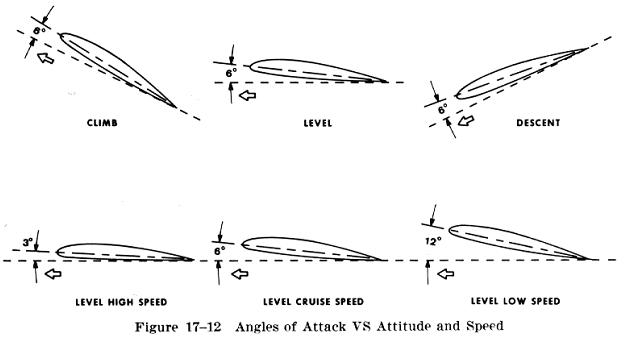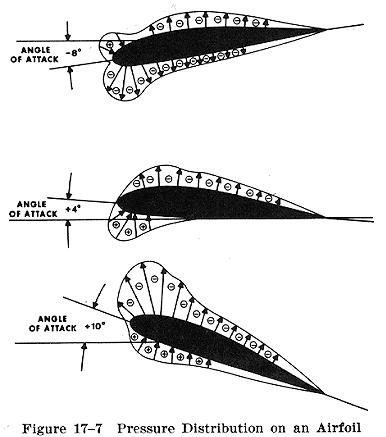
Angle of attack must not be confused with an airplane's attitude in relation to the earth's surface, or with "angle of incidence" (the angle at which the wing is attached relative to the longitudinal axis of the airplane). Angle of attack is most frequently defined as the angle between the chord line of the wing, and the relative wind. Generally, it is sufficient to say that angle of attack is simply the angular difference between where the wing is headed and where it is actually going. As can be seen from Figure 17-12, this angle may be precisely the same for climbs, descents, and level flight, or can be quite different even when maintaining the same altitude.

The feature that complicates this problem is that with
certain exceptions, we have no way of actually seeing the angle at which
the wing meets the relative wind. Angle of attack indicators usually are
found only in the turbojet powered airplanes.
In a very real sense the angle of attack is what flight
in airplanes is all about. By changing the angle of attack the pilot can
control lift, airspeed, and drag. Even the total load supported in flight
by the wing, may be modified by variations in angle of attack, and when
coordinated with power changes, and auxiliary devices such as flaps, slots,
slats, etc., is the essence of airplane control.
| The angle of attack of an airfoil directly controls the
distribution of pressure below and above it. When a wing is at a low but
positive angle of attack, most of the lift is due to the wing's negative
pressure (upper surface) and downwash. (Negative pressure is any pressure
less than atmospheric, and positive pressure is pressure greater than atmospheric.)
From Fig. 17-7 it can be seen that the positive pressure below the wing at a low angle of attack is very slight, and it can be noted also that the negative pressure above the wing is quite strong by comparison. At any angle of attack, other than the angle at zero lift, all the forces acting on the wing as a result of the pressure distribution surrounding it may be summed up and represented as one force - the center of pressure. When the angle of attack increases to approximately 18 to 20 degrees (on most wings), the air can no longer flow smoothly over the top wing surface. Because the airflow cannot make such a great change in direction so quickly, it becomes impossible for the air to follow the contour of the wing. This is the stalling or critical angle of attack, and is often called the burble point. The burbling or turbulent flow of air which begins near the trailing edge of the wing, suddenly spreads forward |
 |
One of the most important things a pilot should understand
about angle of attack is that for any given airplane the stalling or critical
angle of attack remains constant regardless of weight, dynamic pressure,
bank angle, or pitch attitude. These factors certainly will affect the
speed at which the stall occurs, but not the angle. The aerodynamicist
may say that the stalling angle of attack is not always an absolute constant,
but for our purposes here it is a valid, useful, and safe concept.